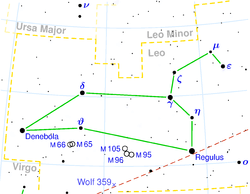Omicron Leonis
 Omicron Leonis is located to the lower far right on this map of the constellation. | |
| Observation data Epoch J2000.0 Equinox J2000.0 | |
|---|---|
| Constellation | Leo |
| Right ascension | 09h 41m 09.03s |
| Declination | +09° 53' 32.30" |
| Apparent magnitude (V) | +3.52[1] |
| Characteristics | |
| Spectral type | F8-G0III/A7m[2] |
| U−B color index | 0.21[1] |
| B−V color index | 0.49[1] |
| Astrometry | |
| Proper motion (μ) | RA: -143.20[3] mas/yr Dec.: -37.20[3] mas/yr |
| Parallax (π) | 25.03[3] ± 0.22 mas |
| Distance | 135 ly (41.4±0.1[4] pc) |
| Orbit[4] | |
| Period (P) | 14.498064 ± 0.000009 days |
| Semi-major axis (a) | 4.46 ± 0.01 mas |
| Eccentricity (e) | 0 |
| Inclination (i) | 57.6 ± 0.1° |
| Longitude of the node (Ω) | 191.4 ± 0.1° |
| Periastron epoch (T) | TJD 10629.831 ± 0.003 |
| Details | |
| Mass | 2.12/1.87 ± 0.01[4] M☉ |
| Radius | 5.9±0.5/2.2±0.3[4] R☉ |
| Luminosity | 39.4±2.4/15.4±1.0 [4] L☉ |
| Temperature | 6,000±200/7,600±400[4] K |
| Age | 8 × 108(estimate)[4] years |
| Other designations | |
| Database references | |
| SIMBAD | data |
Omicron Leonis (ο Leonis, abbreviated Omicron Leo, ο Leo), also named Subra,[5] is a binary star in the constellation of Leo, west of Regulus, some 130 light years from the Sun, where it marks one of the lion's forepaws.
Nomenclature
ο Leonis (Latinised to Omicron Leonis) is the star's Bayer designation.
It bore the traditional name Subra.[6] In 2016, the International Astronomical Union organized a Working Group on Star Names (WGSN)[7] to catalogue and standardize proper names for stars. The WGSN approved the name Subra for this star on 12 September 2016 and it is now so entered in the IAU Catalog of Star Names.[5]
Properties
The primary is given the type F8-G0III giant and the secondary (Subra-B) is type A7m dwarf.[4] Their combined apparent magnitude is +3.52.
References
- 1 2 3 Ducati, J. R. (2002). "VizieR Online Data Catalog: Catalogue of Stellar Photometry in Johnson's 11-color system". CDS/ADC Collection of Electronic Catalogues. 2237: 0. Bibcode:2002yCat.2237....0D.
- ↑ Ginestet, N.; Carquillat, J. M. (2002). "Spectral Classification of the Hot Components of a Large Sample of Stars with Composite Spectra, and Implication for the Absolute Magnitudes of the Cool Supergiant Components". The Astrophysical Journal Supplement Series. 143 (2): 513. Bibcode:2002ApJS..143..513G. doi:10.1086/342942.
- 1 2 3 Van Leeuwen, F. (2007). "Validation of the new Hipparcos reduction". Astronomy and Astrophysics. 474 (2): 653–664. arXiv:0708.1752
 . Bibcode:2007A&A...474..653V. doi:10.1051/0004-6361:20078357.
. Bibcode:2007A&A...474..653V. doi:10.1051/0004-6361:20078357. - 1 2 3 4 5 6 7 8 Hummel, C. A.; Carquillat, J. -M.; Ginestet, N.; Griffin, R. F.; Boden, A. F.; Hajian, A. R.; Mozurkewich, D.; Nordgren, T. E. (2001). "Orbital and Stellar Parameters of Omicron Leonis from Spectroscopy and Interferometry". The Astronomical Journal. 121 (3): 1623. Bibcode:2001AJ....121.1623H. doi:10.1086/319391.
- 1 2 "IAU Catalog of Star Names". Retrieved 28 July 2016.
- ↑ Jim Kaler's website: http://stars.astro.illinois.edu/sow/subra.html (online 6th Sep 2015)
- ↑ IAU Working Group on Star Names (WGSN), International Astronomical Union, retrieved 22 May 2016.
External links
- Omicron Leo/Subra in Kaler Stars
- Subra (HIP 47508) Relates to the A star, Subra-B
- Subra - Omi Leonis brief data.
This article is issued from Wikipedia - version of the 10/1/2016. The text is available under the Creative Commons Attribution/Share Alike but additional terms may apply for the media files.